Why use Kubernetes? This is an important question every organization should ask. After the cloud and virtualization technologies disrupted the infrastructure management in the first landscape, containerization is taking it to the next level.
The advent of Docker popularized containerization. When containers run into hundreds and thousands, it becomes challenging for administrators to orchestrate container lifecycle tasks. This is where container orchestration tools come to the rescue. Kubernetes is a leader when it comes to container orchestration. This blog answers why using Kubernetes is essential for your enterprise and a quick introduction to Kubernetes Architecture.
Table of contents
- What is Kubernetes?
- What is a Container Orchestration System?
- Why use Kubernetes?
- The State of Kubernetes Market
- What is K8S?
- Features of Kubernetes
- A Quick Introduction to a Kubernetes Architecture
- What is Docker?
- What are Containers?
- Why do you need Docker containers with Kubernetes?
- Container Orchestration Systems based on Kubernetes
- Kubernetes Use Cases
- Who uses Kubernetes?
- Kubernetes Cheat Sheet
- Conclusion
- FAQs
What is Kubernetes?
Kubernetes is an open-source container orchestration tool that enables administrators to seamlessly deploy, manage, and scale containerized apps in a wide variety of production environments. It abstracts the underlying host infrastructure from the application; this way, apps that are decoupled into multiple containers can run as a single unit. The tool handles the entire lifecycle of container apps. Google initially developed it to manage large-scale container apps in production environments. Even though Google donated Kubernetes to the Cloud Native Computing Foundation (CNCF) in 2014, it continues to contribute to the development of Kubernetes actively.
Kubernetes was written in the Go programming language. It works on a wide variety of platforms and cloud deployment models. By organizing apps into a cluster of containers that run on virtualized host OS, Kubernetes enables businesses to manage IT workloads efficiently. It uses a Master / Worker architecture wherein a master node controls and manages worker nodes that execute container workloads via an API Server.
Before delving deep into why use Kubernetes, it is important to understand what container orchestration is all about.
What is a Container Orchestration System?
As the name suggests, a container orchestration system orchestrates container management tasks. Be it creating a container, deploying or terminating it, the container orchestration system powered by a containerization tool manages the entire lifecycle. It enables you to manage a fleet of containerized apps distributed across multiple deployment environments.
For instance, Docker CLI can be used to perform container activities such as starting, running and terminating containers or pulling and uploading images to the registry. This process works well when there are only a few containers. Managing a fleet of apps from the Docker CLI becomes a complex task as the number of containers grows and when they are distributed across multiple systems.
This is where a container orchestration tool is required. A container orchestration system extends the container lifecycle management capabilities to container clusters that are complexly deployed across different environments. The container clusters can be managed as a single logical unit when the underlying host infrastructure is abstracted.
Why use Kubernetes?
Kubernetes was originally developed by Google and released as open-source in 2014. Today, it is a standard for container orchestration and virtualization management software. All major cloud providers have integrated it with their cloud platform to offer Kubernetes-as-a-Service. Google, along with other partners in the ecosystem such as IBM, Red Hat, and Intel, is actively supporting the innovation of the tool. The governance model is clear and the growing ecosystem speaks about the long-term viability of the tool.
Since Kubernetes is programming-language-agnostic, platform-agnostic, and OS-agnostic, it offers a wide range of deployment options. You can fully leverage immutable infrastructure and containerization technologies to scale apps on-demand while optimizing resources to the core massively. DevOps teams prefer Kubernetes because of its operations-centric design. At the same time, developers appreciate how it’s not heavily prescriptive, unlike other PaaS offerings. They can easily package apps using its flexible service discovery and integration feature.
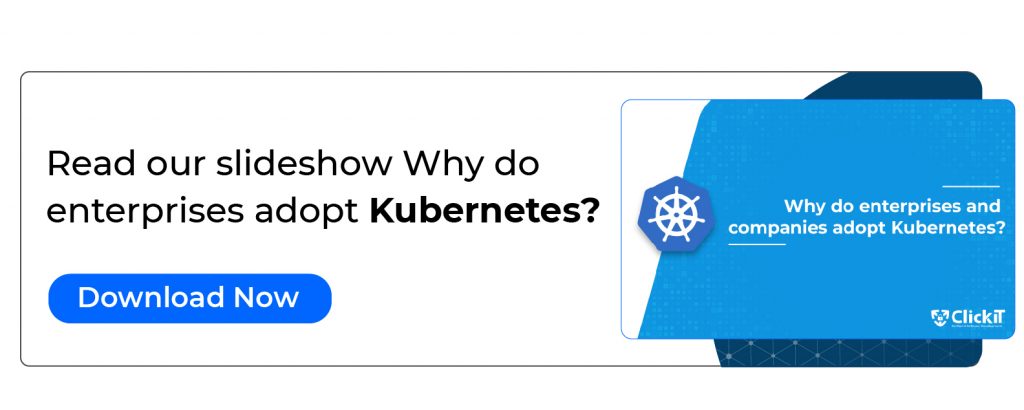
The State of Kubernetes Market
Kubernetes Enterprise adoption is constantly increasing. The recent pandemic and lockdown forced many companies to undergo accelerated digital transformations and as a result, the adoption of Kubernetes rapidly increased.
According to a 2021 Kubernetes Adoption Survey by Portworx, its adoption grew by 68% during the pandemic. While accelerating deployments was the primary driver of Kubernetes adoption, it also resulted in a 30% reduction in costs, contributing to its success. 84% of respondents reported that they use Kubernetes for resource-intense and massive scale purposes such as AI test models and infrastructure automation, which speaks volumes about how massively you can scale and manage infrastructure operations using this tool.
When it comes to benefits, 73% ranked it at the top for ‘faster time to deploy new apps’ while 61% stated it is easy to update apps and reuse code across different environments. Moreover, 59% of responders benefitted from reduced IT and staffing costs. When it comes to salaries, IT professionals with Kubernetes expertise can earn between $100,000 and $250,000 per year.
According to Statista, 50% of organizations are using Kubernetes as of 2021. The global container and Kubernetes market earned a revenue of %0.7 billion in 2020. This value is expected to touch $ 8.24 billion by 2030, growing at a CAGR of 27.4% between 2021 and 2030, reports Allied Market Research.
In the virtualization management software segment, Kubernetes enjoys a market share of 24.73%. It is not surprising that the software industry tops the chart for Kubernetes usage with 32%, followed by the ITES industry with 15% and Financial Services with 5.6%, as per Enlyft.
What is K8S?
The term Kubernetes is derived from a Greek word that means pilot or helmsman. K8S is a short form or abbreviation of Kubernetes. The number 8 refers to the eight alphabets that stand between ‘K’ and ‘S’ in the word (K U B E R N E T E S).
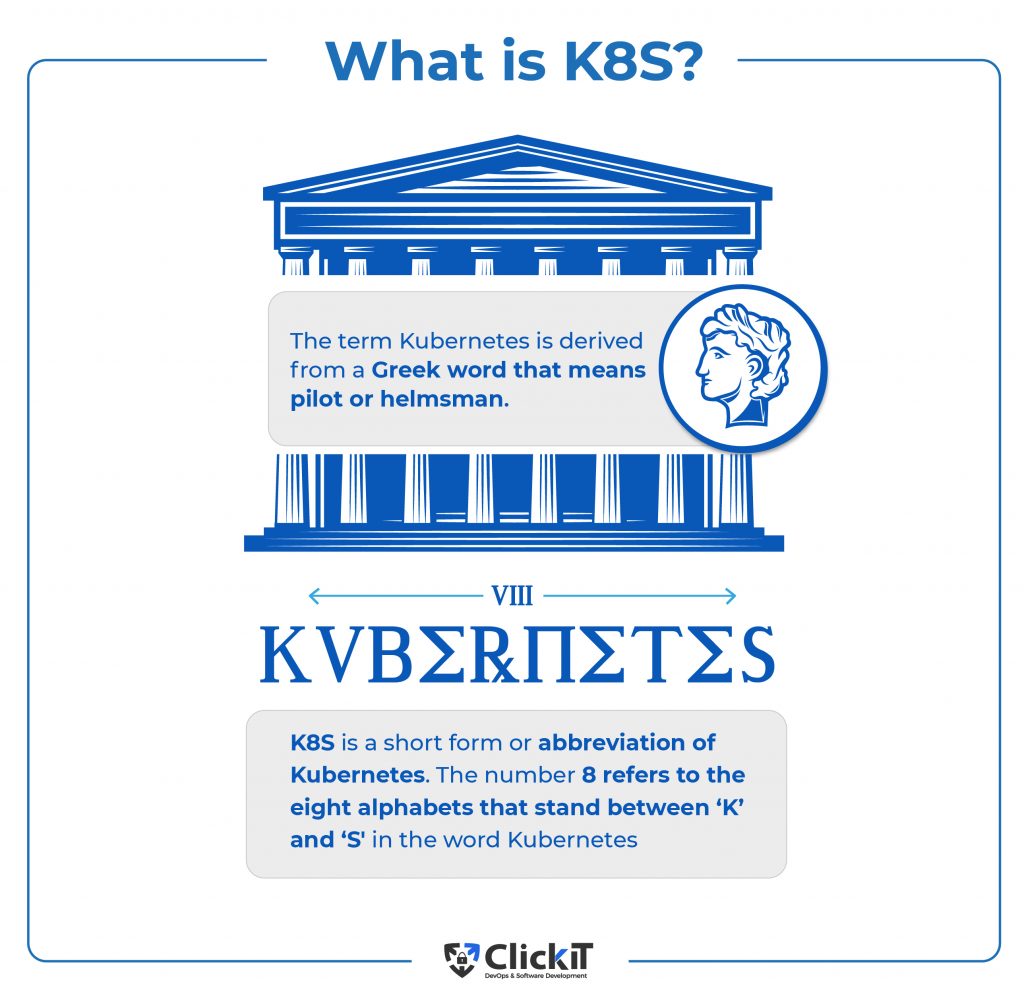
Features of Kubernetes
The core functionality of Kubernetes is container orchestration. In addition, the ability to automatically create, terminate and scale containers facilitates an immutable infrastructure. Here are some of its core features offered:
- Kubernetes abstraction facilities auto-scaling of infrastructure on-demand, vertical and horizontal scaling
- Automated Scheduling of containers while specifying where the containers run and how the containers are launched.
- It automatically rollbacks your apps in case any discrepancies are detected.
- The Kubernetes infrastructure comes with a self-healing ability.
- Storage Orchestration enables administrators to choose the specific storage systems for different apps.
- Kubernetes is not confined to container orchestration. It also manages storage, network and security.
And the list goes on and on. Here are some of its advanced features:
- Helm is a package manager for managing Kubernetes apps using charts like gauge chart that contain Kubernetes manifest files and descriptions of packages. Helm Charts come with predefined reproducible builds that make the deployment of apps faster and easier.
- Feature Gates is a function that turns a feature of a node on and off.
- Cluster Federation is a feature that aggregates multiple K8S clusters into a single logical cluster.
- Customer Scheduler enables you to customize the management of special pods.
- Sidecar is a feature that runs a proxy container within a pod.
- Taints and Tolerations feature makes pods attract or repel each other
A Quick Introduction to a Kubernetes Architecture
A basic Kubernetes architecture consists of the following core components:
1) Kubernetes Control Plane (Master)
a. API Server
b. Scheduler
c. Controller Manager
d. etcd (Distributed Storage System)
2) Nodes or Compute Machines or Kubelets ( Physical or Virtual)
a. Container Runtime Engine
b. Pods
c. Kubernetes Proxy Server
d. Kubernetes Service
Here is Kubernetes Architecture diagram with the components above.
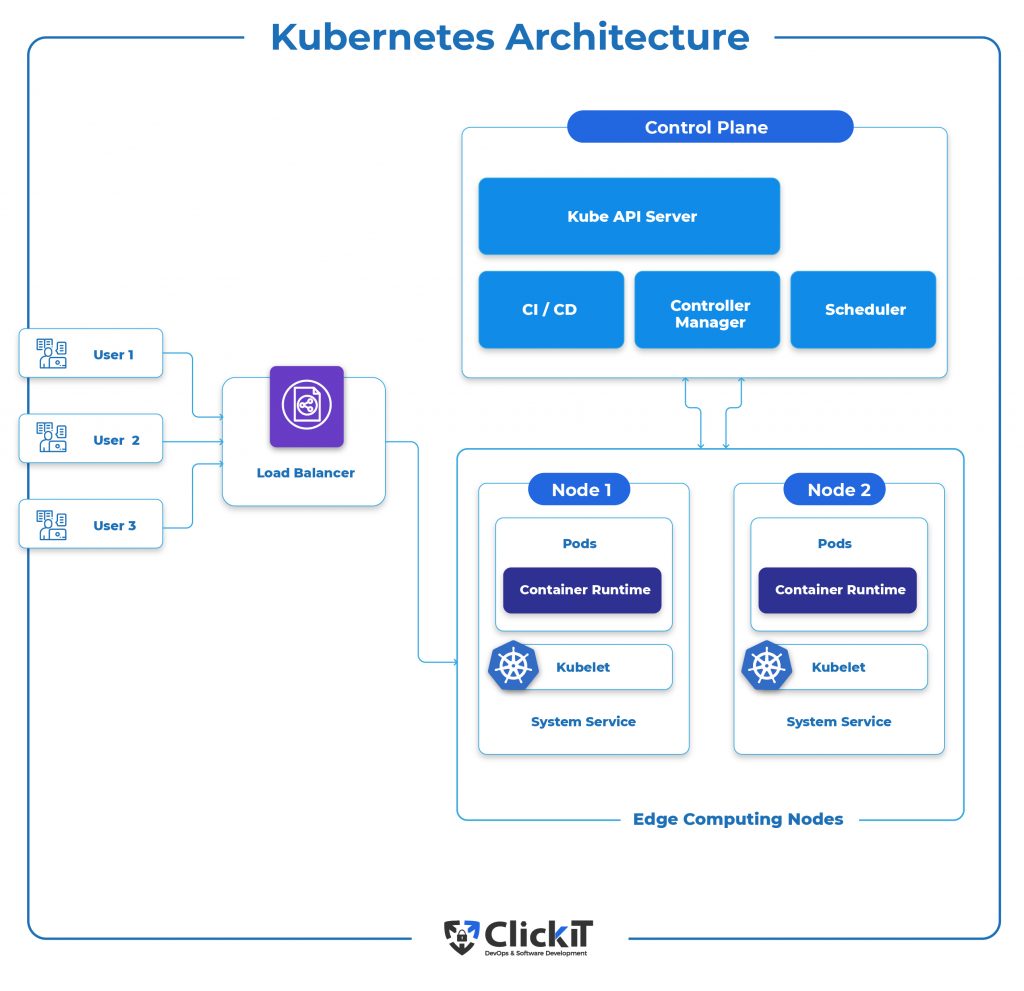
Kubernetes Control Plane
The Kubernetes control plane is the core component of the Kubernetes Architecture that controls clusters by maintaining the record of the objects and ensuring that the object states are always in the desired state. It comprises the following components:
a) Kubernetes API Server: The API server is the front-end of the Control Plane that exposes the API. It manages the lifecycle orchestration of applications by providing different APIs for apps to perform specific functions while acting as a gateway for clients to access clusters.
b) Kubernetes Controller Manager: It is the daemon that manages the object states, always maintaining them at the desired state while performing core lifecycle functions.
c) Kubernetes Scheduler: As the name says, the scheduler in the Kubernetes Architectureschedules node clusters across the infrastructure. It stores the node usage data, monitors the health of each cluster and determines the time and location of deployment of containers if required.
d) Etcd (Distributed Storage Database): It is an open-source and distributed key-value storage database that manages the configuration and state of clusters using the Raft consensus algorithm. Acting as a single source of truth, etcd provides the required information for the control plane related to nodes, containers and pods.
Kubernetes Nodes / Kubelets
Nodes are machines that run containers. Each node contains a primary node agent called Kubelet. It is the important component of Kubernetes architecture that drives the container execution layer. They are managed by the control plane and connect various apps with infrastructure resources such as storage, compute and network components. Here are the basic components of nodes:
a) Container Runtime Engine: It manages the container lifecycle running on node machines and supports runtime engines such as Docker, rkt and CRI-O that are compliant with Open Container Initiative.
b) Pods: A Kubernetes pod is the most basic and smallest deployable object on a node, containing one or more containers. It represents a single instance of running processes within a cluster. It provides shared storage and network resources for containers. Pods are not self-healing which means they get deleted when the node is terminated.
c) Kubelet Service: It is the agent that manages how pods should run in a cluster based on pod specifications instructed by the control plane via the API server and ensures all containers are healthy and available.
d) Kube-proxy: The proxy service running on a Kubernetes node is Kube-proxy, which acts as a load balancer for network packets of TCP, UDP and SCTP streams.

What is Docker?
Docker is a popular open-source containerization technology that enables administrators to package applications into containers along with associated libraries, registries and configuration files using OS-level virtualization and deploy them across a wide variety of environments.
Docker Engine is the software that hosts containers. Docker Inc. is the company that developed and released Docker in 2013. Docker containers are lightweight owing to the high-level Docker API, which means you can simultaneously run multiple containers on a single virtual machine or server. They can be deployed on popular OS environments such as Windows, macOS and Linux environments and public, private and on-premise locations. Container execution processes can be monitored using kernel features.
The Docker architecture contains three core components:
- Docker Sofware (dockerd): It is the Docker daemon that manages containers and their objects. Users can communicate with dockerd using Docker client software called ‘docker’ via a CLI.
- Docker Objects: Objects required to package an application into a container are called Docker objects. E.g.: Docker containers, Docker images and Docker Service.
- Docker Registries: Docker image repositories.
When Docker containers are run on macOS, Docker uses the Docker virtual machine. Docker uses Linux kernel isolation and OverlayFS file system features on Linux environments, enabling a single Linux instance to run multiple containers.
Read our blog bout Docker alternatives for your SaaS app.
What are Containers?
A container is a software package that includes software dependencies such as libraries, OS-level apps, 3rd party code, etc. As such, administrators get the flexibility to run multiple apps on a single virtual machine or a server while being able to seamlessly move them across various environments. Containers run on top of the underlying hardware and the host OS, sharing the OS kernel and other dependencies. With the underlying infrastructure abstracted, containers are lightweight and highly portable. By sharing a common OS, containers reduce the burden of software maintenance as you have to handle a single OS which translates into reduced overhead costs.
Compared with virtual machines, containers consume fewer resources as multiple containers share a single OS kernel. While a virtual machine typically weighs several gigabytes, containers are normally around 500 MB as they don’t require a full OS. Containers can start and terminate in a few seconds because they don’t need the entire operating system to get started.
Why do you need Docker containers with Kubernetes?
As the development landscape rapidly embraces DevOps workflows and microservices architectures, containers rightly fit into their scheme of things. They are lightweight, portable and enable developers to build and deploy applications across heterogeneous IT environments seamlessly. They deliver consistent performance, eliminating software conflicts.
The concept of containerization has been around for three decades. Linux Containers (LXC) used to be highly popular. However, the advent of Docker brought containers into the mainstream. Docker standardized the container ecosystem, and by 2013, a majority of companies adopted it as a default runtime for containers.
Docker is highly portable, which means you can deploy and run containers in the cloud, on-premise, desktops, and a variety of devices. The ability to run separate containers for each process offers high availability as administrators can perform app updates and modifications without any downtime. You can reuse images and track and roll them back if needed. Docker is also famous for its vibrant community, which adds up to these advantages and makes it a standard for containerization. Containers can be easily built, deployed, and managed using a containerization tool such as Docker.
You need a robust container orchestration tool when Docker containers run into hundreds and thousands. But why use Kubernetes? Simply because it perfectly solves containerization challenges. When you combine Docker and Kubernetes, you get the best of both worlds. While Docker handles the containerization segment, Kubernetes takes care of the orchestration part. Especially for your enterprises that massively scale containers, Kubernetes and Docker serve a great purpose. Docker comes with in-built Kubernetes integration, improving developers’ efficiencies while building containerized apps.
Read our blog Kubernetes vs Docker to learn more about this debate
Container Orchestration Systems based on Kubernetes
Owing to its increasing popularity, major cloud providers have integrated Kubernetes into their cloud offerings as a managed Kubernetes service, eliminating the need to maintain a separate Kubernetes environment with control planes.
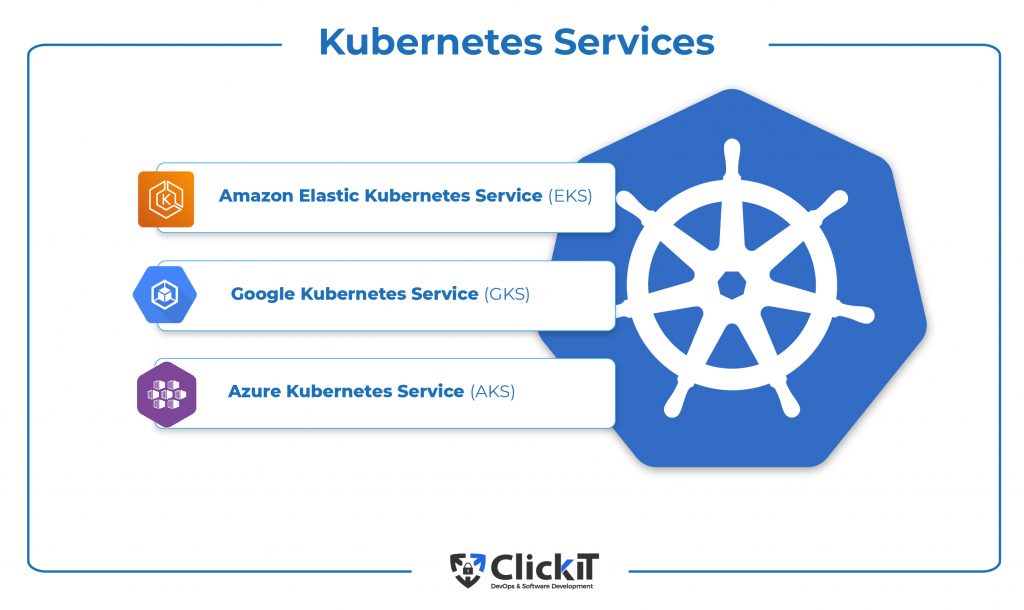
Amazon Elastic Kubernetes Service (EKS)
Amazon EKS is a fully-managed Kubernetes service offered by AWS that helps you to automatically spin containers and manage them with ease. EKS Control Plane comes with 3 Kubernetes master nodes running on Amazon-controlled VPC that are located in 2 different zones for high availability. The Kubernetes API traffic is managed by the Amazon network load balancer.
Amazon EC2 instances run the worker nodes on user-controller VPNs. EKS offers the flexibility of running multiple apps on a single EKS cluster or configuring a single app or environment per each cluster. It automatically updates the Kubernetes software version. However, there is a bit of manual work required for updating cluster components. You can manage Kubernetes clusters using the kubectl CLI. EKS supports autoscaling. However, you need to integrate 3rd party solutions for resource monitoring. Each deployed cluster will cost you $0.20 per hour.
Learn how to deploy Kubernetes cluster with Amazon EKS.
Azure Kubernetes Service (AKS)
It is the integrated Kubernetes-as-a-Service launched by the Azure cloud platform in 2018. AKS offers the flexibility, security and automation required to build, deploy and manage container clusters powered by the Azure architecture. AKS offers three options to create and manage clusters in the form of Azure PowerShell, Azure Portal and Azure CLI.
Kubernetes plane nodes are automatically configured by AKS. Clusters can be easily upgraded with a single command. The tight integration with Azure Active Directory provides a high level of security. Autoscaling is available with two services, Cluster Autoscaler and Horizontal Pod Autoscaler. Azure Monitor is a handy tool that helps you to monitor cluster operations from a central pane. Application Insights is another tool that monitors it’s components with the support of service-mesh tool Istio. When it comes to availability, AKS stands next to GKS, delivering datacenter services in Africa as well. Cluster management is free.
Google Kubernetes Service (GKS)
It is the fully-managed Kubernetes service powered by the Google Cloud Platform. Because it was developed by Google, GKE quickly gained popularity among developer circles. GKE is a mature solution and comes with robust features such as autoscaling, automated cluster management and upgrades, integrated resource monitoring etc. GKE focuses on hybrid cloud models wherein Kubernetes clusters can be moved across cloud, on-premise and other environments with ease. When it comes to releases, GKE is the first one to update the Kubernetes software with the latest release. It automatically updates clusters (Control plane and worker nodes).
You can use Kubectl CLI to run commands against Kubernetes clusters. GKE comes with Stackdriver, a Google cloud service for managing logging and resource monitoring tasks. GKE scores high in availability as well, providing services in Africa and Latin American regions. Autoscaling is another feature that makes GKE a good option for large-scale enterprise apps. GKE provides cluster management for free.
Kubernetes Use Cases
Continuous Delivery (CI/CD)
Kubernetes can play a crucial role in the continuous deployment (CD) part of the DevOps CI/CD pipeline. As developers build code using the CI server, Kubernetes automates deployments. Popular CI servers such as GitLab come with a built-in container registry that leverages the platform in CI/CD pipelines.
Infrastructure Automation
In a microservices architecture powered by DevOps, Kubernetes makes a strong case for managing workloads. It helps administrators in infrastructure automation, wherein applications can be easily deployed and managed across different environments. The ability to scale selected components or services without affecting the app in any way enables organizations to scale apps while optimizing costs. Similarly, versioning of deployments helps monitor and roll of containers, if needed.
Cloud Migration
Organizations that are planning to migrate their on-premise data centers to the cloud using the ‘Lift and Shift’ method can migrate the entire app into large Kubernetes pods and then break them into smaller components once you get the hang of the cloud. It reduces migration risks while helping them to fully leverage the cloud benefit.
Multi-cloud Deployments
Multi-cloud environments comprise different cloud deployments such as public, private, on-premise, bare metal, etc. Since apps and data move across various environments, managing resource distribution is a challenge. Kubernetes abstraction enables the automated distribution of computing resources across multi-cloud environments, which means organizations can efficiently distribute workloads across multiple cloud providers.
Serverless Architecture
Serverless architecture is quickly gaining momentum as it allows businesses to develop code without worrying about the provisioning of the infrastructure. In this type of architecture, the cloud provider provisions resources only when a service is running. However, vendor-lock-in is a big hindrance to the serverless concept as code developed for one platform faces compatibility issues on another cloud platform. When Kubernetes is used, it abstracts the underlying infrastructure to create a vendor-agnostic serverless platform. Kubeless is an example of a serverless framework.
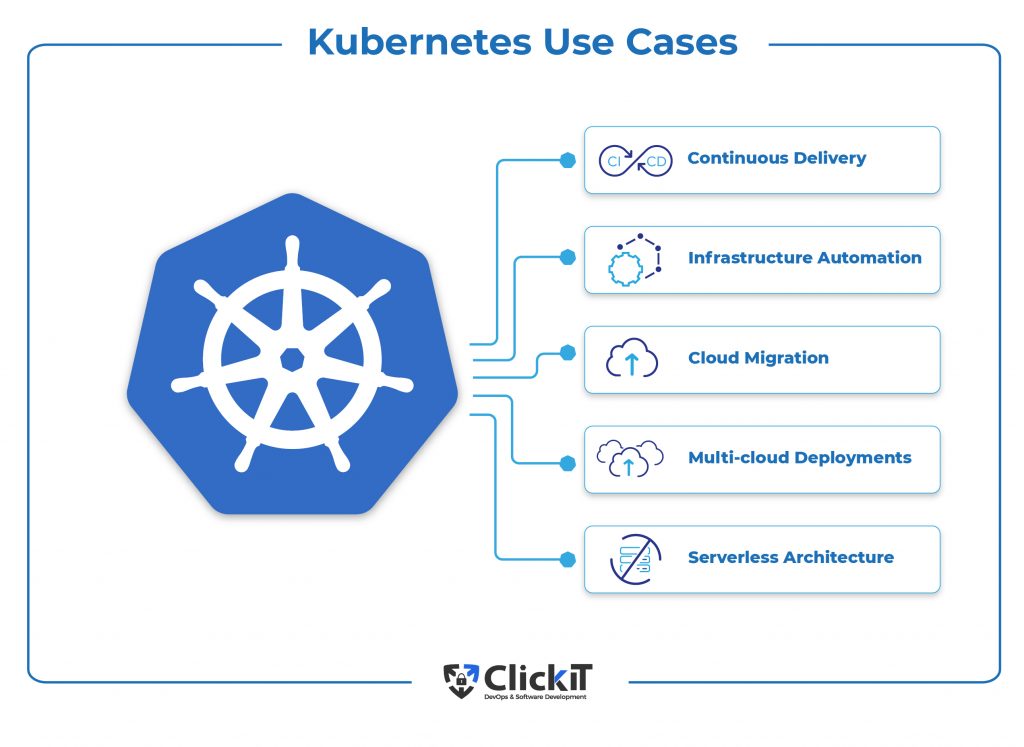
Who uses Kubernetes?
After pondering on why use Kubernetes, the next interesting question that comes to mind is who uses Kubernetes. Considering that Google developed Kubernetes, it is not surprising that it uses the open-source Kubernetes platform. Spotify, New York Times, Pinterest, Booking.com, Adidas, etc. are some of the popular companies in the list of 25,290 companies that use Kubernetes.
| Company | Kubernetes Platform |
|---|---|
| Spotify | Spotify uses microservices architecture and Docker with Helios. The company migrated from Helios to Kubernetes in 2018. The company runs 1600 production servers and 14 multi-tenant production clusters in three availability regions and is able to make 6.26 production deployments per week |
| Booking.com | The company built its own Vanilla Kubernetes platform. Now, it is able to create a service within 10 minutes. Within the first eight months of Kubernetes adoption, the company created and deployed 500 new services |
| AppDirect | Operates 15 Kubernetes clusters deployed on AWS on On-premise. Prometheus is the monitoring tool integrating with the Kubernetes platform. The company is able to make 1,600 deployments per week |
| The company uses Docker and Jenkins Kubernetes clusters. With auto-scaling, Pinterest saves 30% fewer instance hours when compared to static clusters | |
| Adidas | The company adopted Kubernetes along with Prometheus for monitoring clusters. Adidas runs 40% of critical systems on Kubernetes using 4000 pods, 200 nodes and 80,000 builds per month and 3-4 releases per day. The e-commerce site load time reduces to half |
Kubernetes Cheat Sheet
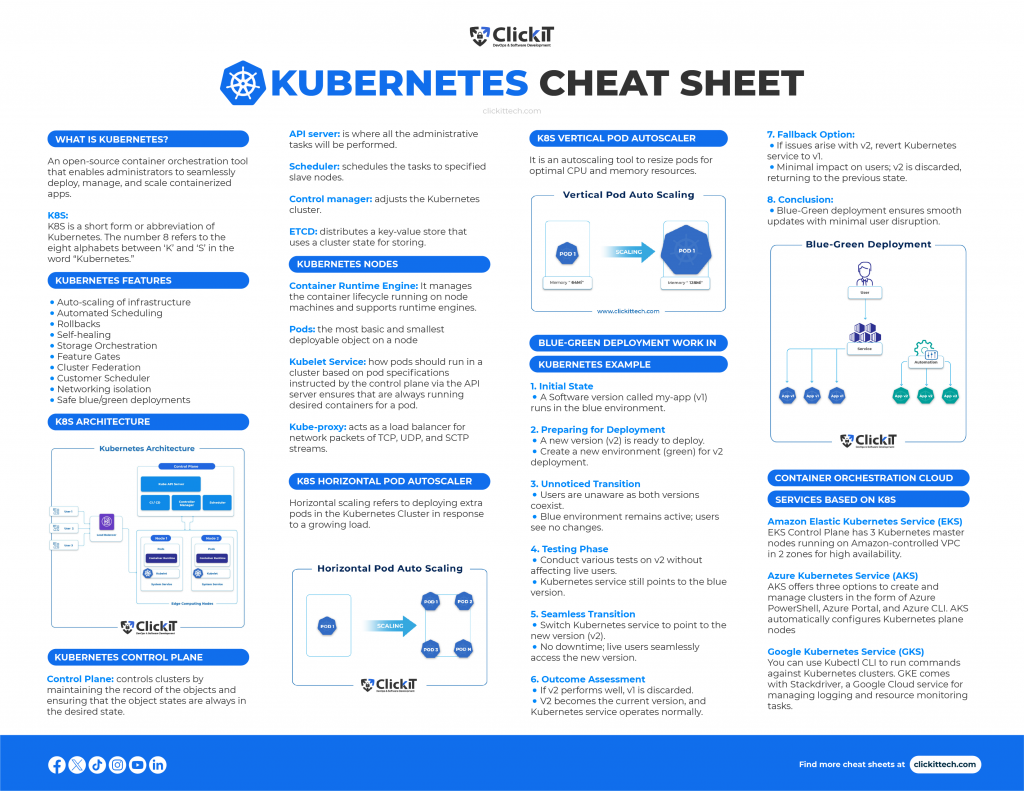
Conclusion
The container ecosystem is rapidly evolving and getting jam-packed as well. Right from startups to enterprises and PaaS vendors, everyone is trying to make their mark in this space. However, Docker and Kubernetes stand tall and have cemented their place for a few years from now. Especially Kubernetes, considering that it is powered by big names such as Intel, IBM, Red Hat, Huawei and Google. As such, the capabilities are rapidly improving which makes it safe to assume that it is here to stay and rule the container ecosystem.
Now, the question is not about why use Kubernetes but why we didn’t use Kubernetes until now. Leveraging the amazing power of this tool will surely push you ahead of the competition.
This blog is also available on Medium
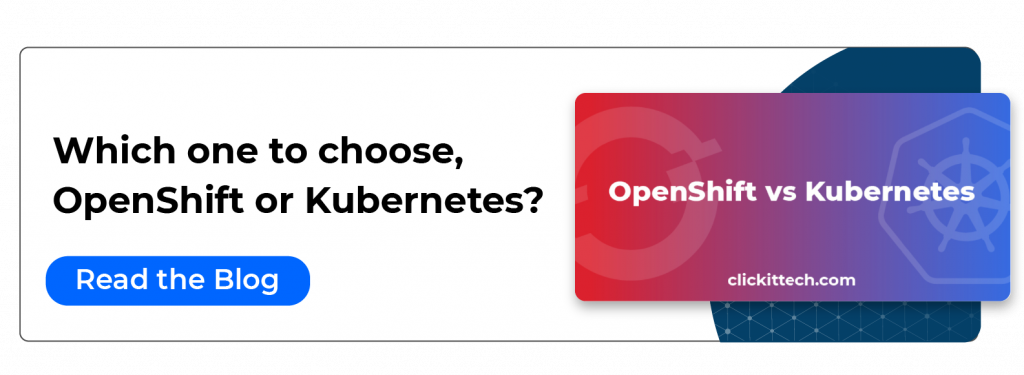
FAQ
You should choose the model of web applications based on the number of databases and servers used in the application. There are three When it comes to container orchestration, Kubernetes is the best one. However, there are alternatives to try like Docker Swarm, Apache Mesos and Nomad.
Kubernetes comes with a robust operations-centric architecture that is highly scalable, resilient. Plus, it has container self-healing capabilities and supports zero runtime. It is designed to efficiently manage large-scale containers apps that are distributed across complex and multi-cloud environments.
While Kubernetes offers amazing benefits to businesses, it also comes with a steep learning curve. Here are a couple of options that simplify operations:
Kubernetes Fully-managed Services: You can use Kubernetes fully-managed services such as Amazon Elastic Kubernetes Service (EKS), Google Kubernetes Engine (GKE) and Azure Managed Service (AKS).
Kubernetes-powered PaaS: Platform-as-a-Service (PaaS) providers offer cloud platforms integrated with Kubernetes. However, they don’t offer the full functionality of the tool. OpenShift, Rancher and Densify are a few examples in this segment.
It offers a wide range of deployment options. You can fully leverage immutable infrastructure and containerization technologies to scale apps on-demand while optimizing resources to the core massively.








